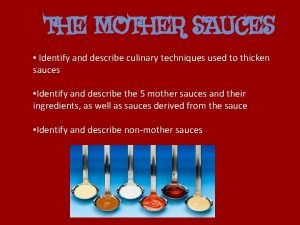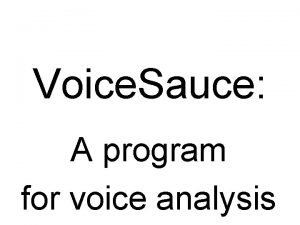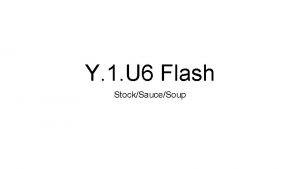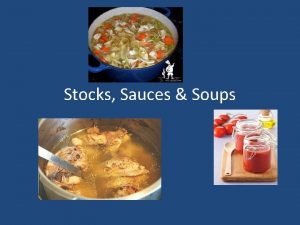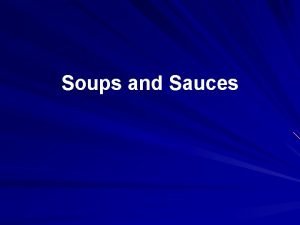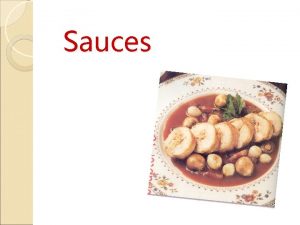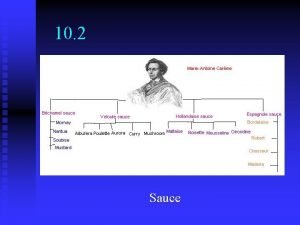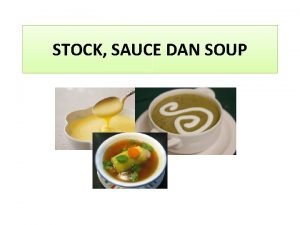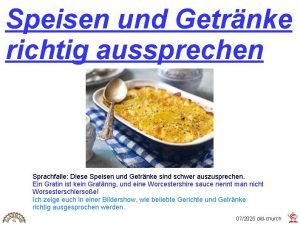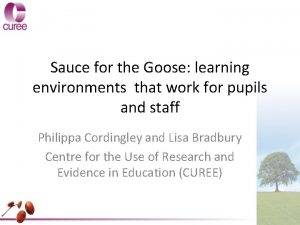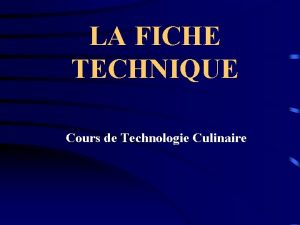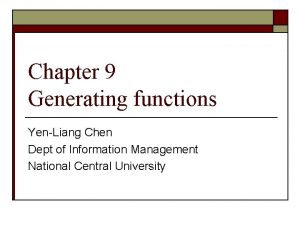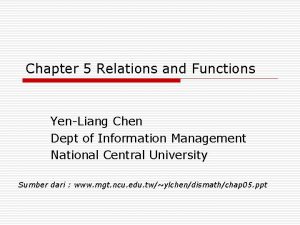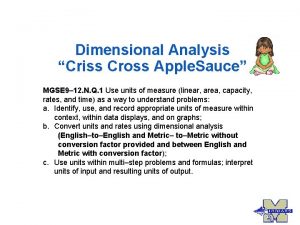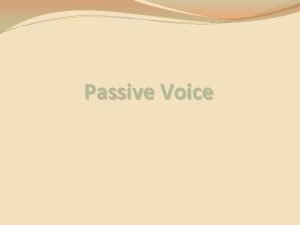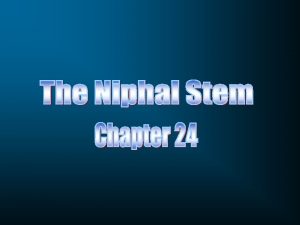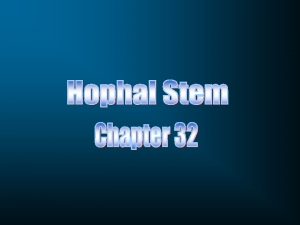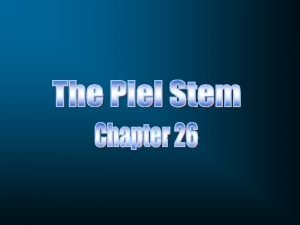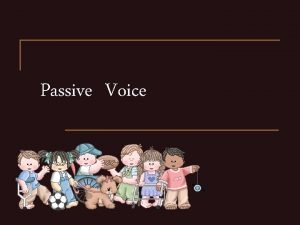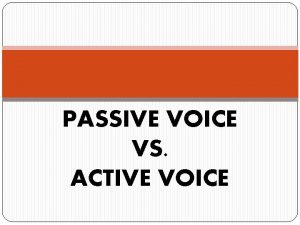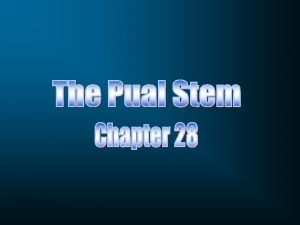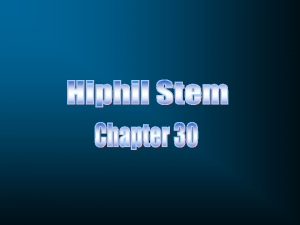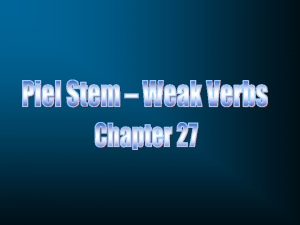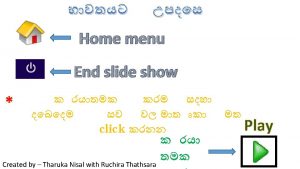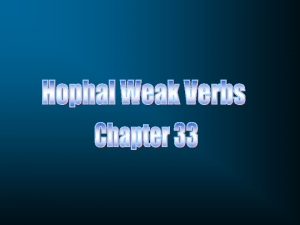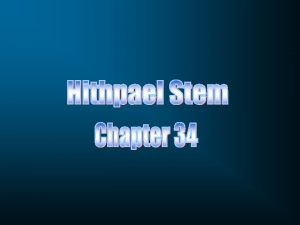Voice Sauce A program for voice analysis YenLiang





















![Speech corpus • Voice measures made for low vowel [a], after 9 Georgian stops Speech corpus • Voice measures made for low vowel [a], after 9 Georgian stops](https://slidetodoc.com/presentation_image_h/093159d6e5e101bd628d3820ca259364/image-22.jpg)










- Slides: 32

Voice. Sauce: A program for voice analysis

Yen-Liang Shue Speech Processing and Auditory Perception Laboratory Department of Electrical Engineering, UCLA yshue@ee. ucla. edu

Patricia Keating Chad Vicenik Phonetics Lab, Linguistics, UCLA

Overview • Voice. Sauce is a new application, currently implemented in Matlab, which provides automated voice measurements over time from audio recordings. • Voice. Sauce computes many voice measures, including corrections formant frequencies and bandwidths. • It outputs values as text or for Emu database. • Voice. Sauce is available free by downloading.

Voice. Sauce algorithms: F 0 estimation • First the STRAIGHT algorithm (Kawahara et al. 1998) is used to find F 0 at 1 ms intervals. • The Snack Sound Toolkit (Sjölander 2004) can also be used to estimate F 0 at variable intervals. • Future versions will allow integration with other F 0 estimators.

Voice. Sauce algorithms: Harmonic magnitudes • Harmonic spectra magnitudes are computed pitch-synchronously, over a 3 -cycle window. This eliminates much of the variability in spectra computed over a fixed time window. • Harmonics are found using standard optimization techniques to find the maximum of the spectrum around the peak locations as estimated by F 0. This enables a much more accurate measure without relying on large FFT calculations.

Voice. Sauce algorithms: Formants estimation • The Snack Sound Toolkit (Sjölander 2004) is used to find the frequencies and bandwidths of the first four formants, using as defaults the covariance method, preemphasis of. 96, window length of 25 ms, and frame shift of 1 ms (to match STRAIGHT). • Future versions will allow integration with other formant estimators.

Voice. Sauce algorithms: Formant corrections • In previous work, Iseli & Alwan (2000, 2004) developed an algorithm that estimates the voice source parameters F 0, H 1*-H 2*, and H 1*-A 3*, where the asterisk denotes that the corresponding spectral magnitudes (H 1, H 2 and A 3) are corrected for the effect of formants (frequencies and bandwidths). Further developments have been reported by Iseli et al. (2006, 2007).

• In Voice. Sauce, the harmonic amplitudes for all measures of spectral magnitude are corrected every frame using the Snack formant frequencies and bandwidths. (For H 1*-H 2*, only F 1 and F 2 are used in the correction; for e. g. H 1*-A 3*, F 1 through F 3 are used. ) • Finally, the measures are smoothed with a moving average filter with a default length of 20 samples.

Variables computed • F 0 from Snack • F 0 from STRAIGHT • F 1 -F 4 and B 1 -B 4 from Snack • H 1 • H 2 • H 4 • A 1, A 3 • Cepstral Peak Prominence • Energy • • • H 1 -H 2(*) H 1 -A 1(*) H 1 -A 2(*) H 1 -A 3(*) H 2 -H 4(*) • All harmonic measures come both corrected (*) and uncorrected

Voice. Sauce: User Interface

Module: Parameter estimation User specifies: • Where to find. wav files to analyze, and where to save. mat files of results • Acoustic parameters to be calculated (next slide) • whether to limit analysis to segments in Praat textgrid for each file (next slide) • whether to display waveform of each file during its processing

Parameter selection Default setting is that all available parameters will be calculated:

Using Praat textgrids in parameter estimation • Praat textgrids (Boersma 2001) are used to delimit and label segments of interest. • These can then be used to guide Voice. Sauce acoustic analysis (only labeled segments are analyzed). • They are also used to structure Voice. Sauce output.

Module: Settings Change how parameters are calculated, how textgrids are used:

Module: Output to text • From Praat textgrids, Voice. Sauce identifies all labeled segments. • Writes out the results for those segments – all values (frame interval) or, – averages over N intervals • User specifies which parameters to output. • Output can be one giant text file with all parameters, or separate smaller text files with subsets of parameters.


Including EGG data • EGGWorks, a free program by Henry Tehrani based on PCQuirer. X, computes several EGG measures from. wav files of EGG channels, in batch mode. • Its output file can be included as an input to Voice. Sauce’s output step.

Module: Output to Emu • For use in Emu speech databases (Harrington in press) • Emu’s trackdata files in SSFF format • One track file per parameter per audio file as in Emu • Can view, query, analyze in Emu, or in R using Emu library

Sample display in Emu

Comparing Voice. Sauce to other methods • Compare Voice. Sauce’s outputs to – By hand measurements, taken from FFT spectra (traditional method) – Praat (Boersma 2001) • Same speech materials all three methods – Taken from Vicenik (2008)
![Speech corpus Voice measures made for low vowel a after 9 Georgian stops Speech corpus • Voice measures made for low vowel [a], after 9 Georgian stops](https://slidetodoc.com/presentation_image_h/093159d6e5e101bd628d3820ca259364/image-22.jpg)
Speech corpus • Voice measures made for low vowel [a], after 9 Georgian stops – Three stop types - voiceless aspirated, voiced, ejective – Three places of articulation – bilabial, alveolar, velar – Measurements averaged over the first third of the vowel (Praat, Voice. Sauce), or measured immediately after vowel onset (by hand) • Five speakers – middle-aged women from Tblisi, Georgia

H 1 -H 2 by hand Measured in PCQuirer – Created FFT spectrum with 21 Hz Bandwidth and 40 ms window – Spectrum taken at vowel onset – Manually marked and logged H 1 and H 2 using cursor – Very slow – Many files could not be analyzed H 1 H 2

H 1 -H 2 by Praat • Using a new script based on one by Bert Remijsen (his “msr&check_f 1 f 2_indiv_interv. psc”) • Measures H 1 -H 2, H 1 -A 1, H 1 -A 2 and H 1 A 3 for each labeled segment on a tier • Not pitch-synchronous, not corrected • If Praat cannot find F 0 or all three formants, a file is skipped

H 1 -H 2 by Voice. Sauce • All Voice. Sauce measures computed, but some are not available from other methods • Here, uncorrected spectral magnitude measures were used

H 1 -H 2 for three consonant manners By-hand vs. Voice. Sauce vs. Praat Bilabial 15 H 1 -H 2 10 5 0 -5 -10 Aspirated Ejective By Hand Voiced Aspirated Ejective Voice Sauce Voiced Aspirated Ejective Praat Voiced

Differences • Overall results from the 3 methods are similar. • Measurements made by hand have the smallest H 1 -H 2 range; Praat has largest H 1 -H 2 range (larger category differences). • BUT Praat measurements also have greater variation than from Voice. Sauce or by hand – about twice as much for nonmodal phonation.

What makes Praat more variable? • H 1 and H 2 measures both more variable • Some possible reasons: – the STRAIGHT pitch-tracker used in Voice. Sauce is very good – having F 0 values every msec avoids discontinuities – harmonic amplitudes are found by optimization, which is equivalent to using a very long FFT window

Conclusions • We hope that Voice. Sauce will be a useful and easy-to-use tool for researchers interested in multiple voice measures over running speech. • Future versions will incorporate additional features.

Download Voice. Sauce • Voice. Sauce is free • Currently requires Matlab to run • Future versions will be compiled executables • Available now from: http: //www. ee. ucla. edu/~spapl/voicesauce/

References • • • Boersma, P. (2001) “Praat, a system for doing phonetics by computer”, Glot International 5: 341 -5. Harrington, J. (in press 2010) Phonetic Analysis of Speech Corpora, John Wiley and Sons Iseli, M. and A. Alwan (2000) “Inter- and Intra-speaker Variability of Glottal Flow Derivative using the LF Model, '' 6 th International Conference on Spoken Language Processing, ICSLP 2000. Volume 1, pp. 477 -480 Iseli, M. and A. Alwan (2004) "An Improved Correction Formula for The Estimation of Harmonic Magnitudes and Its Application to Open Quotient Estimation, " Proceedings of IEEE ICASSP, May 2004, pp. 669 -672 Iseli, M. Y. Shue and A. Alwan (2006) “Age- and Gender-Dependent Analysis of Voice Source Characteristics'', Proceedings of IEEE ICASSP, vol. I, May 2006, pp. 389 -392 Iseli, M. , Y. -L. Shue and A. Alwan (2007) “Age, sex, and vowel dependencies of acoustic measures related to the voice source“, J. Acoust. Soc. Am. 121, 2283 -2295 Kawahara, H. , A. de Cheveign, and R. D. Patterson (1998) “An instantaneous-frequency-based pitch extraction method for high quality speech transformation: revised TEMPO in the STRAIGHTsuite, ” in Proceedings ICSLP’ 98, Sydney, Australia, December 1998 Remijsen, B. , Praat scripts: http: //www. ling. ed. ac. uk/~bert/praatscripts. html Sjolander, K. (2004) "Snack sound toolkit, " KTH Stockholm, Sweden. http: //www. speech. kth. se/snack Tehrani, H, (2009) EGGWorks, a program for automated analysis of EGG signals. Vicenik, C. (2008). “An Acoustic Analysis of Georgian Stops. ” Unpublished UCLA Masters Thesis.

Acknowledgments • NSF grant BCS-0720304 • Code contributors: Henry Tehrani and Markus Iseli • Voice. Sauce beta users: Kristine Yu, Christina Esposito, Sameer Khan, Marc Garellek, Jianjing Kuang • Co-PIs: Abeer Alwan and Jody Kreiman
 Five mother sauces
Five mother sauces Voice sauce
Voice sauce A liaison is a thickener made from a mixture of
A liaison is a thickener made from a mixture of Thickening agents for sauce
Thickening agents for sauce Mother sauces names
Mother sauces names Classification of sauces
Classification of sauces Tomato sauce derivatives
Tomato sauce derivatives Squiggly spaghetti
Squiggly spaghetti Mother sauces derivatives
Mother sauces derivatives Teknik pengolahan makanan dalam pembuatan stock adalah
Teknik pengolahan makanan dalam pembuatan stock adalah Bourbon vanille aussprache
Bourbon vanille aussprache Worcestersauce ddr
Worcestersauce ddr Sauce: physical classroom
Sauce: physical classroom Kriteria sauce yang baik
Kriteria sauce yang baik Anziil
Anziil Kriteria sauce yang baik
Kriteria sauce yang baik Code couleur fiche technique cuisine
Code couleur fiche technique cuisine Chapter 6 stocks sauces and soups
Chapter 6 stocks sauces and soups Pasta sauce pairing
Pasta sauce pairing Breathe the same air as you
Breathe the same air as you Kontinuitetshantering i praktiken
Kontinuitetshantering i praktiken Typiska novell drag
Typiska novell drag Nationell inriktning för artificiell intelligens
Nationell inriktning för artificiell intelligens Ekologiskt fotavtryck
Ekologiskt fotavtryck Shingelfrisyren
Shingelfrisyren En lathund för arbete med kontinuitetshantering
En lathund för arbete med kontinuitetshantering Kassaregister ideell förening
Kassaregister ideell förening Tidböcker
Tidböcker A gastrica
A gastrica Vad är densitet
Vad är densitet Datorkunskap för nybörjare
Datorkunskap för nybörjare Tack för att ni lyssnade bild
Tack för att ni lyssnade bild Att skriva en debattartikel
Att skriva en debattartikel
